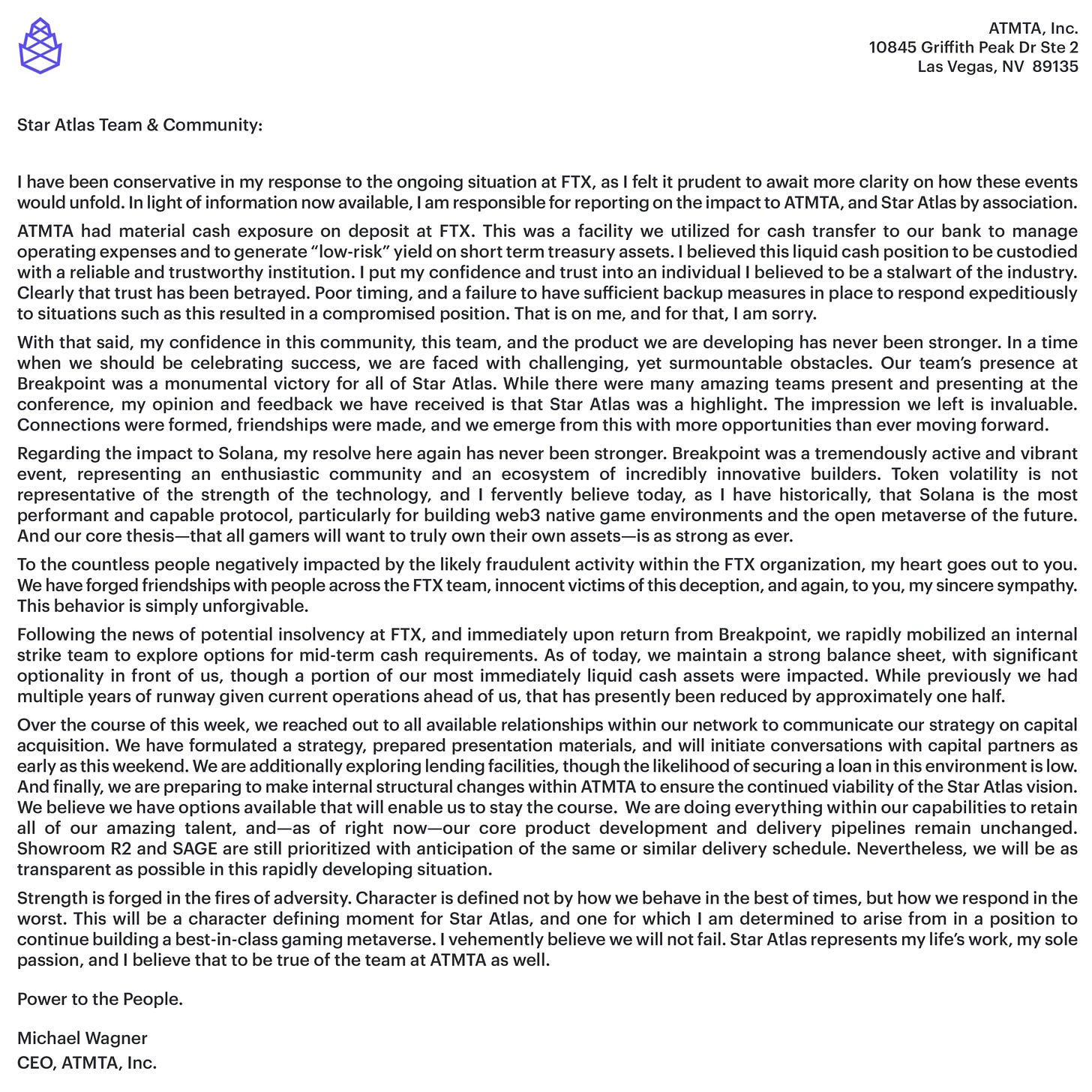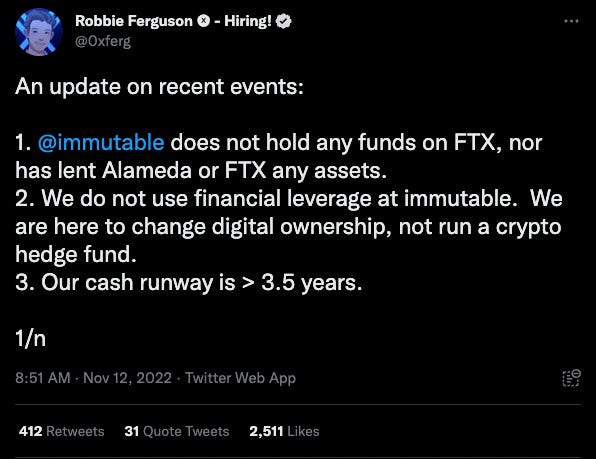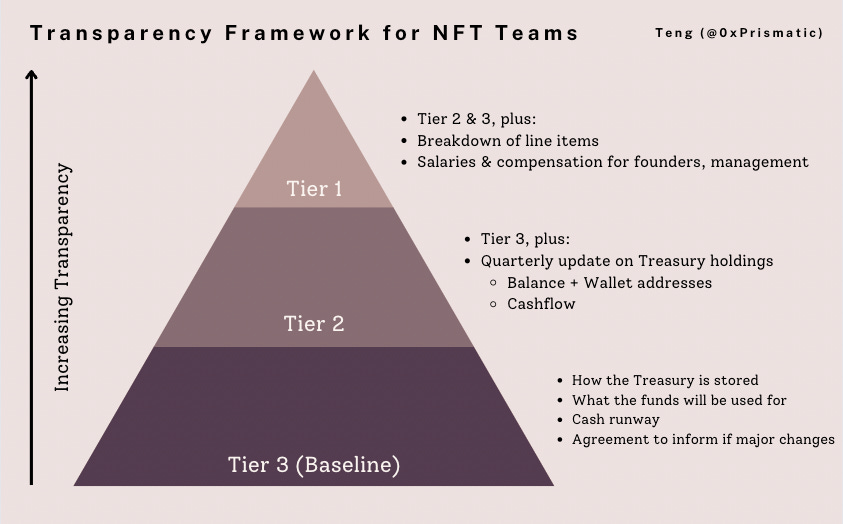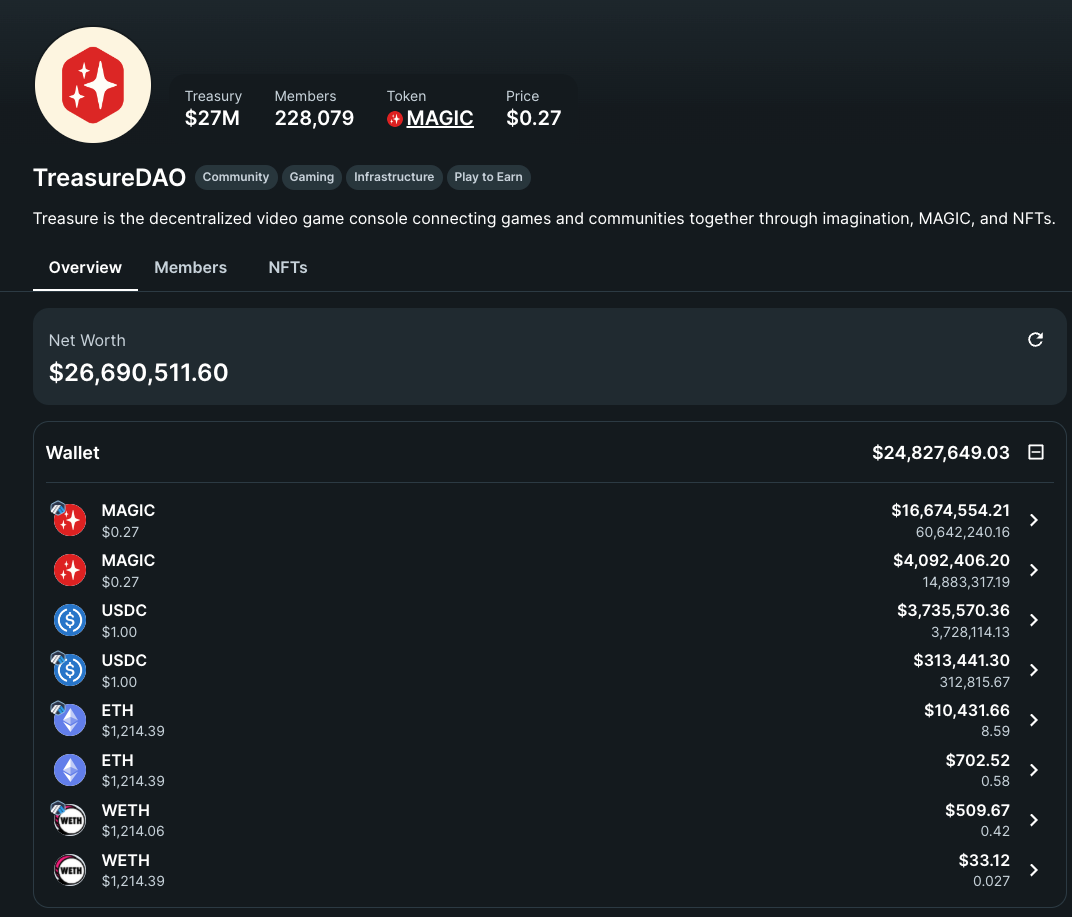Post-FTX Fallout: Transparency Over Translucency
NFT teams & their communities have a symbiotic relationship, which is critical for transparency
2022 is the year that will be forever etched in our minds.
Let’s count the blowups:
Terra/Luna death spiral: Retail + Funds hurt. Lots of forced selling
3AC + Celsius collapse: Retail + Funds + Lenders hurt. More forced selling
FTX / Alameda bankruptcy: Retail + Funds + Lenders + Project treasuries hurt.
DCG / Genesis next?
That’s a massive dollop of pain. Anyone still here is either a true believer in the future of crypto or a degen gambler who cannot quit.
For many, the shocking bankruptcy of FTX is the straw that broke the camel’s back. The extent of the lies, fraud and blatant misuse of customer funds by SBF and his inner circle is disgusting. $10B of customer funds vanished into thin air, only brought to light by a bank run.
If there’s one common thread among these blowups, it is a severe lack of transparency. How ironic it is: happening in an industry that prides itself on the ideals of transparency and decentralization achieved via the blockchain.
Did The FTX Blowup Impact NFT Teams?
After the blowup, I spent some time checking in on NFT teams to see how impacted they were by the FTX situation. Among the 36 teams I looked at:
🔸 5% had considerable exposure to FTX
🔸 8% had a small exposure but not materially affecting operations
🔸 87% were not affected
Two teams were heavily affected: Star Atlas (AAA game on Solana in development) and bywassies (Memetic PFP brand by loomdart).
For Star Atlas, this is an existential crisis. Approximately 50% of their treasury funds were kept on FTX to generate “low-risk” yields. The team had previously raised $10M from VCs and is still far from launching the game. Given the development resources required for a AAA game, it is uncertain if they can deliver fully. Double whammy cos Star Atlas is building on Solana, which is dealing with its own existential crisis.
bywassies had 60% of their liquid cash on FTX (now lost). Yet, the team says they will continue building the brand along their roadmap. For PFPs, the direct impact is less strongly felt. IRL Activations and brand-building efforts will be slower, but the community is still the most important at the end of the day.
It begs the question: Why was such a big part of their treasuries on FTX instead of a multisig, non-custodial wallet? Were they trading or taking on high-risk positions, with funds raised from their community and investors?
Otherwise, it was reassuring that most NFT teams were not directly affected.
(For a full list of teams I looked at and my sources, you can refer to this Google Sheet. Please feel free to fork and use it.)
Translucent More Than Transparent
What I found interesting, however, was the stark differences in transparency and risk management among teams.
At one end of the transparency spectrum, there were teams that quickly and openly shared their exposure and how much cash runway they had.
On the other end, some teams didn’t bother to issue a public statement and briefly stated that they were not affected when probed by their community members.
And still, some teams haven’t come out to talk about their exposure even after a week. Silence is telling here.
Community Ownership = Greater Transparency.
NFT teams are a very unique and precious type of organization. They are incredibly heterogeneous. Many started simply as a creative idea and bootstrapped their way to existence. Often, there was a sale of NFTs for initial funding with no involvement from professional investors. The founder is king. There are no rules in place.
Importantly, NFT teams have a community of people who believe in their vision, often willing to support them financially and participate in the co-creation process. Their success depends, in no small part, on their community. It’s this symbiotic relationship that makes Web3 so interesting.
In my view, NFT owners (i.e., community) are a tier of ownership between shareholders and the general public. The expected level of reporting & transparency to the community should lie somewhere in between — and closer to that expected for shareholders.
While there are no legal frameworks to enforce this, the level of transparency founders decides to pursue with their community reflects how deeply they believe in decentralization and community ownership. If they truly believe that community members are more akin to “shareholders,” they will aim for a higher level of trust and transparency within their community.
A Simple Transparency Framework For NFT Teams
I have taken the liberty to put together a simple 3-Tier transparency framework for NFT teams.
Tier 3 (Baseline)
How & where the treasury funds are stored, including who has access to the funds (e.g., multisig signers)
What will the funds be used for
Agreement to update the community if there are any significant changes.
Regular updates on expected cash runway: how long can the project run before running out of funds
These 4 points are the baseline expectations we should have of any NFT team. It is straightforward and does not require much effort, yet it goes far in building trust. Over time, teams can work their way up the tiers as they gain confidence and embrace the benefits of transparency. Teams that do not attempt to meet this baseline should be red-flagged.
Tier 2
All of Tier 3, plus:
Quarterly update on Treasury holdings
Treasury balance & Wallet addresses
Cashflow: Total Revenue vs. Total Expenditure
In Tech, VC-backed startups often must provide monthly cashflow statements to their key investors. Similarly, if Web3 teams regard their community as part-owners in the project, a truncated view of the treasury balances and cashflows should be shared.
A star example of this is TreasureDAO, a decentralized “Nintendo” for games. They have publicly shared their treasury wallet addresses and made it easy for members to track the treasury value and usage in real-time via Zapper.
Tier 1
All of Tier 1 & 2, plus:
Breakdown of various line items, including salaries & compensation for founders/management team.
This is the highest echelon of transparency. It requires proper accounting records to be kept and founders to embrace a mindset of openness. A few Web2 companies like Buffer have set the example. They have been openly transparent with all of their employee’s salaries, viewing it as a way to establish a culture of trust.
I recognize that it is a fine line between privacy and transparency. Being transparent means your competitors know what you are up to. This can lead to an informational advantage. But:
Most NFT teams aren’t competing against each other. Rather, they are competing against the traditional, non-Web3 world.
I strongly believe that the winning teams are the ones that will be able to deftly navigate this, building strong bonds of trust with their community while staying very competitive.
Importantly, we need checks and balances to avoid Ragnarok-type situations that make the industry look like a circus — the project raised $17.5M from NFT sales in the bull market this year, and the founder paid himself $1.2M in salaries annually while losing another $1M of treasury funds by trading.
Actions speak louder than words. NFT teams that vocally espouse the ideals of the community but deliberately avoid talking about their treasury and financials are hypocritical. Beware, for they only see you as a customer.
Let's hold ourselves and our teams to higher standards. Only then can we move forward in confidence, knowing we have a solid foundation to lean on. Our future is bright, BUT we cannot keep giving opportunities for bad actors to rise to the top.
Startup, Not A Hedge Fund
A final note: NFT projects are not hedge funds. Treasury funds are meant for growing the business. Trading or yield farming using treasury funds without informing the community (or investors) is a severe breach of trust. For the vast majority of teams, keeping funds safely as cash in a bank or non-custodial multi-sig wallets should be viewed as the gold standard.
In the future, I can see the potential business for sophisticated financial players to help cash-rich startups with treasury management while minimizing risks.
The FTX–Alameda–SBF debacle has taught us a lesson in transparency. Founders need to think intentionally about this and hold themselves and their teams up to higher standards. Community members must play their part and ensure their teams are accountable. Otherwise, we will never be taken seriously as an industry. Star Atlas is an unfortunate victim — it could have been prevented.
You can find and DM me on Twitter (@0xPrismatic). I love getting your feedback.
Subscribe to The Metadata for the most informative and entertaining daily newsletter on NFTs, gaming, and the metaverse.








